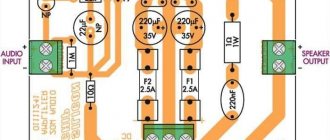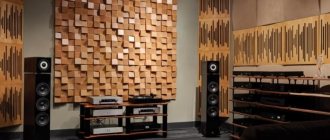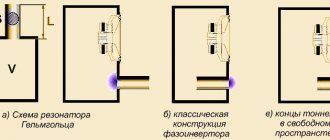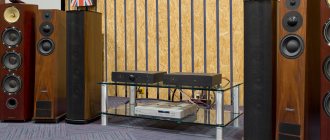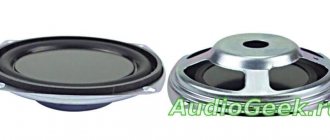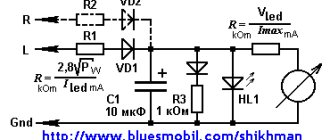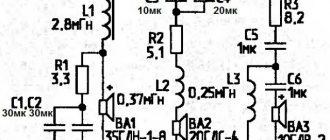How does the nature of the musical material affect the maximum permissible power of the speakers?
Speakers can suffer two types of damage - thermal and mechanical. Let's assume that a 100-watt amplifier fails and begins to produce high-frequency vibrations beyond the audible range. The lightweight tweeter voice coil can almost immediately fail due to overheating. On the other hand, suppose the woofer is constantly being overdriven by turntable rumble, too much bass, low-frequency feedback, or a combination of these factors. After some time, the moving parts of the woofer will be in a stressed state, which can lead to displacement of the voice coil axis and its wear due to friction. In particularly serious cases, the coil may fly out of the gap and hang above the magnetic system, as shown in Fig. 2.
The speaker is in good condition
Speaker is overloaded
Even not very high power can cause such damage; in the case of an ultra-low frequency signal, only 20-30 W is sufficient. Common engineering practices require professional systems to use high-pass filters to attenuate signals outside the system's bandwidth.
Manufacturers of audio equipment, when releasing products to the market, must indicate technical characteristics in the passport. It's not easy to navigate them. An inexperienced buyer, at best, will ask the seller about the amplifier's power, frequency band, or, at worst, about distortion. And, as a rule, he will receive a formal answer: the amplifier power is 100 watts, the frequency band is no worse than 20 Hz - 20 kHz, distortion is three hundredths, which means 0.03%. However, many amplifiers have similar characteristics. Achieving them nowadays is not a difficult task, but with the same characteristics, devices can sound differently. So what should you pay attention to first?
Each link in the reproduction chain has its own special characteristics, we intend to indicate them separately for acoustics, amplifiers (pre-amp and power), players (vinyl and CD) and other signal sources and converters.
Let's start with the most popular and necessary - a preamplifier. In English it is often called Line preamp, Control amp, Phono amp, Head amp, that is, a device designed to work with various signal sources. So, let's look at its main technical characteristics.
Pre-amplifier characteristics:
Frequency range or bandwidth of reproduced frequencies Frequency response
Depending on the signal source, it is indicated by two inputs. The input of the pickup head indicates the deviation of the frequency response from the level at a frequency of 1 kHz, in the frequency band 30 Hz - 15 kHz, or 20 Hz - 20 kHz (depending on which standard the manufacturer uses). For example: Frequency response Disc input (RIAA Ref.1 kHz, 30 Hz to 15 kHz) +0.2/–0.25 dB.
The Aux/Line inputs indicate the frequency response with a certain roll-off at the edges. For example: Frequency resp. Line –0.5 dB, 2 Hz to 100 kHz; –3 dB 0.88 Hz and >200 kHz.
In the first case, the quality of the pickup corrector when playing vinyl records is characterized. Naturally, the smaller the deviation, the better. For high-level equipment, deviations of ± 1 dB are permissible in the band 20 Hz - 20 kHz. The width of the frequency range at the linear input also determines the quality of the device - the wider the frequency band, the better. This is especially true for expansion towards low frequencies, down to direct current.
Total Harmonic Distortion + Noise
They reflect the presence of distortion products in the spectrum of simple (sinusoidal) signals. The amount of total harmonic distortion is a function of frequency at a 1 V output signal. As a rule, it tends to increase at the edges of the range. Harmonic distortion is assessed for the main inputs, separately for MM, MS* and linear input. Indicated as a percentage or in decibels, 0.01% corresponds to minus 80 dB. For transistor technology, figures of the order of 0.005 - 0.05% are typical; for tube technology, 0.1% is an acceptable value. It must be said that the total value of harmonic distortion is not a determining indicator of good sound. This characteristic only formally describes the system’s response to the input signal. As is known, not a single measuring signal is capable of making the system react the way it does when a real sound signal is applied. Nevertheless, the developers strive to minimize any distortion.
Signal to noise ratio S/N ratio (IHF, CCIR, IEC-A)
In parentheses it is indicated which weighing filters were used (they are designated by the name of the organizations that recommend the use of this filter). A preamplifier with a low signal-to-noise ratio will not only make noise like a primus stove, but, much worse, will destroy the subtle musical structure of the sound of voices and instruments. The signal-to-noise ratio is measured in decibels, for each input separately (the input is short-circuited), relative to the output signal with a voltage of 1V and a frequency of 1 kHz. For MS and MM inputs, 70 dB is quite enough. The line input usually has a better value, usually around 85 - 95 dB. There are also champions, such as the Primare Systems Model 201 preamplifier with a 102 dB signal-to-noise ratio at the line input with an IEC-A weighting filter.
Input Sensitivity
Indicates the voltage at the input at which the voltage at the amplifier output will be equal to 1 V. The signal at the source output for each input must be no less than the sensitivity parameter. Otherwise, the signal at the preamp output will have significant noise or will not be sufficient to drive the power amplifier. For example: Input Data (Sensitivity/Loading) Disc (MM)—0.5 mV/47 k, Disc (MC)—0.06 mV/47 Ohms, Aux/CD input—100 mV/50 k. Typical sensitivity values for a preamplifier are the following figures: at the MS input - 0.2 - 0.3 mV, at the MM input - 1 - 3 mV, at the linear input - 100 - 200 mV.
Channel separation
Other terms may be used: Stereo Separation, Crosstalk. Characterizes the penetration of a signal from channel to channel, measured in decibels. In general, the separation between channels tends to decrease as frequency increases, resulting in poor stereo imaging at high frequencies. Typical values for pickup inputs at a frequency of 1 kHz are 80×70 dB, at 20 kHz—50×45 dB. For the linear input, this figure is better by 10-15 dB. It must be said that the best pickups have a channel separation of 30-35 dB at 20 kHz, so many amplifiers with values close to 35-40 dB will sound bad due to loss of localization, stereo depth, and detail at frequencies above 10 kHz. Perhaps the champion in this characteristic can be considered American Hybrid Technology, which has 115 dB in the worst case!
Input/Output impedance
To match MM pickups, the preamp may have an input impedance switch from, say, 10k ohms to 47k ohms. MC heads are designed for a lower impedance. The Canadian amplifier Sonic Frontiers SFP-1, for example, with a standard resistance at the MM/MS input of 47 k, is equipped with a set of resistors from 10 Ohms to 1 kOhms for precise matching with the head used. However, this is hardly convenient for the owner, who must independently decide which resistor to install, and also make sufficiently high-quality soldering. The line input typically has an input impedance of at least 30 kOhm. Lower resistance will create difficulties for compact players, tape recorders, tuners: since their output may not be designed to operate at low resistance, the signal may be greatly attenuated. Output impedance characterizes the system's ability to drive a low-impedance load, for example, the input impedance of an amplifier with a long interconnect cable. For example, the English Art Audio VP1 has an output impedance of 35 kOhm, which with a three-meter cable to the power amplifier and an input resistance of 10 kOhm will give an attenuation of 7 dB at 20 kHz! Therefore, the lower the output impedance of the preamp, the better. A typical value would be 1 kΩ at 1 kHz.
Presence of bias voltage at DC offset output
This characteristic is mandatory for high-quality equipment! For example, 50 mV at the output of a preamp applied to the open input of a power amplifier with a gain of 30 dB will produce about 1.8 V DC at its output! Of course, such voltage cannot damage the speaker system (the midrange and high-frequency heads will be protected by a filter; such voltage is not dangerous for the low-frequency head), but it can cause a significant displacement of the woofer head’s cone. In turn, this will lead to an asymmetry in the location of the voice coil in the magnetic gap and increase distortion in the low-frequency region.
High-end equipment has balanced inputs and outputs, which avoids problems that arise with the appearance of constant voltage at the output of the preamplifier. If you have a single-ended input (RCA connector) of the amplifier, and the amplifier itself does not have a circuit that ensures that there is no constant voltage at the amplifier output (DC servo), then when choosing a preamplifier you should pay attention to this parameter. Note that the value of the output offset may be different for different copies of the same device, but the figure ±10 mV is quite acceptable in all cases.
The given list of technical characteristics is, of course, not exhaustive. We have presented, in our opinion, the main ones necessary when evaluating and choosing a preamplifier.
Power amplifier characteristics:
The task of choosing a power amplifier is no less difficult than choosing a preamplifier. Before making a decision, which is only possible after listening to music, let's look at the passport and get acquainted with the technical characteristics.
Output nameplate power Power output, Rated power
This is the main characteristic of the amplifier. Measured in watts per sine wave at a given load. Usually the power is indicated at a load of 8 and 4 ohms. However, on a music signal, the speaker resistance sometimes drops to 1 ohm. Therefore, it is not harmful to ask the seller how much power the amplifier can deliver at a 2-ohm load. If the amplifier power is indicated at 100 W/8 Ohms and 200 W/4 Ohms, this is an excellent powerful machine that is not afraid of even the lowest impedance speakers. However, it's not about the numbers 100, 200, 500, 1000... If the amplifier has even 20 W/8 Ohm and 40 W/4 Ohm, that's also good. It is important that the power doubles when the load is halved. Such an amplifier has a high overload capacity, and if you change the acoustics to a lower impedance one, the amplifier will not let you down.
The picture is different with tube amplifiers. Here, as a rule, there are several outputs (the output transformer has taps on the secondary winding to connect the corresponding load). If your speaker system has an impedance of 8 ohms, connect it to the 8 ohm output, if 4 ohms - to the 4 ohm output. When connected correctly, the amplifier will deliver the maximum power for which it is designed.
Frequency band, frequency range at –3dB level (at half the rated power) Power bandwidth (–3dB point)
As a rule, transistor amplifiers have a wider frequency range than tube amplifiers (from several hertz to hundreds of kilohertz). For example, the Audio Research D300 amplifier has a bandwidth from zero hertz (direct current) to 150 kilohertz. And the tube V70 from the same company is 12 Hz - 40 kHz, which, however, does not interfere with its high popularity among audiophiles.
Peak output current
Characterizes the power of the power supply and the reliability of the output stage. For the best transistor amplifiers this figure is about ± 30е60А. One can say about such an amplifier that it controls the acoustics “with an iron hand in a velvet glove.” Good tube amplifiers deliver a current of about ± 10е15A to the load. High output currents provide deep, tight bass.
Distortion Characteristics
Both harmonic and intermodulation may be specified. The lower this figure in percentage or decibels, the less distortion this amplifier introduces into the amplified signal. However, it is not the magnitude that is more important, but the spectrum of distortion products. Push-pull amplifiers effectively suppress the second harmonic in the output stage, but can have a long tail of even and odd harmonics. Single-ended tube harmonics are much higher in level, but they quickly decay and, as a rule, there is no distortion in the spectrum above the fifth harmonic.
Tube technology has slightly worse distortion performance, but the already mentioned Audio Research V70, having 1% distortion at a maximum power of 60 W, according to foreign experts, sounds great. Harmonic distortion measurements are carried out at different frequencies, usually 20Hz, 1kHz and 20kHz, and output powers of 1VA, 2/3 rated and at maximum rated. At extreme frequencies and at maximum power, a significant increase in distortion levels can be observed.
In the mid-70s, it was fashionable to list amplifier performance in various intermodulation tests. The concepts of TIM (Transient InterModulation) - transient, DIM (Dinamic InterModulation) - dynamic intermodulation appeared. Currently, the behavior of an amplifier with complex measurement signals is of interest only to specialists and developers. We will only mention standard measurements of intermodulation distortion when simultaneously feeding 2 tones 19 kHz/20 kHz at full power. A good amplifier should have a value in the range of 0.02 - 0.1%.
Input Impedance, Input Sensitivity
A typical figure for impedance is 30 - 100 kOhm. Input impedance below 30k ohms can seriously affect the frequency response of the signal coming from the preamplifier.
Sensitivity refers to the voltage applied to the input at which the amplifier develops its rated power. The usual value is 0.5 - 2 V.
Output Impedance
Characterizes the ability of the amplifier to work equally well on speaker systems with both high and low impedance. There is a misconception that the higher the damping factor (the speaker's nominal impedance divided by the amplifier's output impedance), the better the speaker's bass response. However, a damping coefficient equal to 2000 will be better than 20 by only 5 - 10% in the low-frequency response, i.e. The expected increase in sound pressure at low frequencies is less than 1 dB! However, a very small damping value, say less than 10, can lead to a noticeable change in the frequency response of the speaker.
Power supply power. Energy stored in the capacitors and inductors of the filter. Power supply capacity. Energy storage.
It is this energy that determines the dynamic range during playback. It is measured in joules. A typical amplifier with two 10,000 uF capacitors at 60 V has only 72 J. (Transistor champions have a total capacitance of about 0.5 - 1.0 farads). For comparison, a flash in an average photo studio has 500 - 1000 J. But the Audio Research V140 has 415 J. Imagine what muscles this tube mono amplifier has! Therefore, when this characteristic is given, be sure to pay attention to it.
We deliberately did not provide such characteristics as signal-to-noise ratio, separation between channels, and the presence of constant voltage at the output. They are similar in definition and measurement to those given above for the preamplifier. The parameter limits recommended in this article should not be considered as strict restrictions when choosing amplifiers. Even in high-class amplifiers, deviations of one or two parameters from the ranges given here are possible. The final choice should be determined by the results of the audition.
If you have questions about characteristics not noted here or have your own opinions, please write to the editor.
How are the power ratings of JBL Professional speaker systems calculated?
As noted, the speaker can be damaged as a result of overheating of the voice coil or excessive drive in the low-frequency region. Ideally, we need a standard test signal that takes both of these types of damage into account and at the same time is applicable in practice. It is described by the International Electrotechnical Commission (IEC) standard No. 268-5. This is a pink noise signal with a load crest factor of 6 dB, filtered by 12 dB per octave below 40 Hz and above 5 kHz.
To determine the rated power, a test signal with a gradual increase in power is applied to the speakers being tested and the level they are able to withstand for eight hours is determined. Details of the testing process are shown in Fig. 3.
We already mentioned above that the load crest factor is 6 dB. Let's explain this in detail. Crest factor is related to the crest factor of the signal and is an accurate measure of the peak noise value associated with the average "heating capacity" of the signal to the voice coil. A value of 6 dB means that a particular speaker or transducer is receiving a signal that is four times the average power. For example, if a speaker rated at 150 W was tested using this method, it would be subjected to an instantaneous signal of 600 W for eight hours. This method matches real-world speaker conditions so well that JBL now applies it to all loudspeaker systems, eliminating all previously used power ratings.
Amplifier types
Before buying, you need to study the types of amplifiers to find the optimal device for yourself. Based on functionality, they are divided into 3 large groups.
1. Preliminary “Probe” a weak signal to strengthen it. They are placed next to a source emitting an impulse. This is necessary in order to minimize interference from other electronics. They won’t be able to cope with it alone - they will also need to buy a power amplifier. 2. Terminal (power) They will amplify the signal to the level required for full operation of the acoustics. 3. Complete Combines the 2 devices described above. They are expensive, but in the end they are cheaper than a set of 2 separate devices.
Based on the type of element base, they are divided into tube and transistor devices. Read more about each of them below.
Tube
Ah, that “warm tube sound”! A phrase that has become a cult favorite among everyone who has ever come into contact with the world of audio. The main advantages of such transistors:
- excellent sound with a simple radio circuit - with basic knowledge of radio electronics you can repair it yourself;
- softer sound;
- little outside noise;
- smooth signal limitation when overloaded - the system will not “wheeze” or “hiss”;
- not afraid of short circuits.
The downside of the “lamp” is that when one lamp becomes unusable, finding a full-fledged replacement is quite a challenge! You will have to often surf the forums to select the necessary parts.
Topic: How to choose a soundbar: TOP 9 sound panels for TV
Transistor
Advanced version of the amplifier. Instead of lamps, small microcircuits are used here. So the big plus is compactness. And as a consequence:
1. Minimalistic appearance There is no need to take the “tubes” outside the device, so the transistor stereo amplifier can be an ascetic “cube”. 2. Easy to repair Finding the right transistor is much easier than choosing a lamp.
The main disadvantage follows from the key advantage - they are much more complicated. And if something breaks, you will have to contact specialists. And paying a Hi-Fi acoustics specialist can cost a pretty penny.
There are also hybrid models on the market. They incorporate both the advantages and disadvantages of both types of amplifiers.
Amplitude characteristic
The amplitude characteristic of an amplifier is the dependence of the amplitude of the output signal on the input signal at a fixed frequency. Typically it is 1 kHz.
The amplitude response of an ideal amplifier should, in theory, look like this:
This is a ray that starts from the zero coordinate reference point and extends to infinity.
But in fact, the real amplitude response of the amplifier looks like this:
Here we see that even if the input voltage Uin = 0, then at the output of the amplifier we will still get some signal level. This will be the noise voltage Ush.
Additional tips for choosing an amplifier
The choice should not be reduced to the “coolness” and price of the device. Sometimes mid-budget models show the same results as expensive ones with a well-known brand.
First of all, pay attention to the characteristics described above. We also recommend the following.
1. Buy an amplifier in those retail outlets where it can be heard “in real life.” No reviews can compare with testing the device in “field conditions.” 2. Buy an amplifier with a small power reserve. This is necessary in order not to overload the system, forcing it to work at maximum speed. 3. Consider the area of the room where the system will be installed. For a room of ~15 m², a channel power of 3-4 W/sq.m is enough, but for a hall larger than 25 m², it is better to look for a system with indicators of 5-7 W/sq.m. 4. Look for an amplifier that connects to the acoustics using terminals with threaded clamps. Spring latches are more common, but terminals are more reliable. 5. It is not necessary to chase the TOP Models that are sold much cheaper for 2-3 years, but they are practically not inferior in quality.
Before choosing a stereo amplifier for your home, you need to understand the power of the speakers in advance, find out the condition of the wiring (whether it can handle 2 devices at once) and the size of the room. Only after this do you begin the process of searching for a device.
Instructions: How to connect a Bluetooth speaker to your phone: 2 proven options for 2 OS
